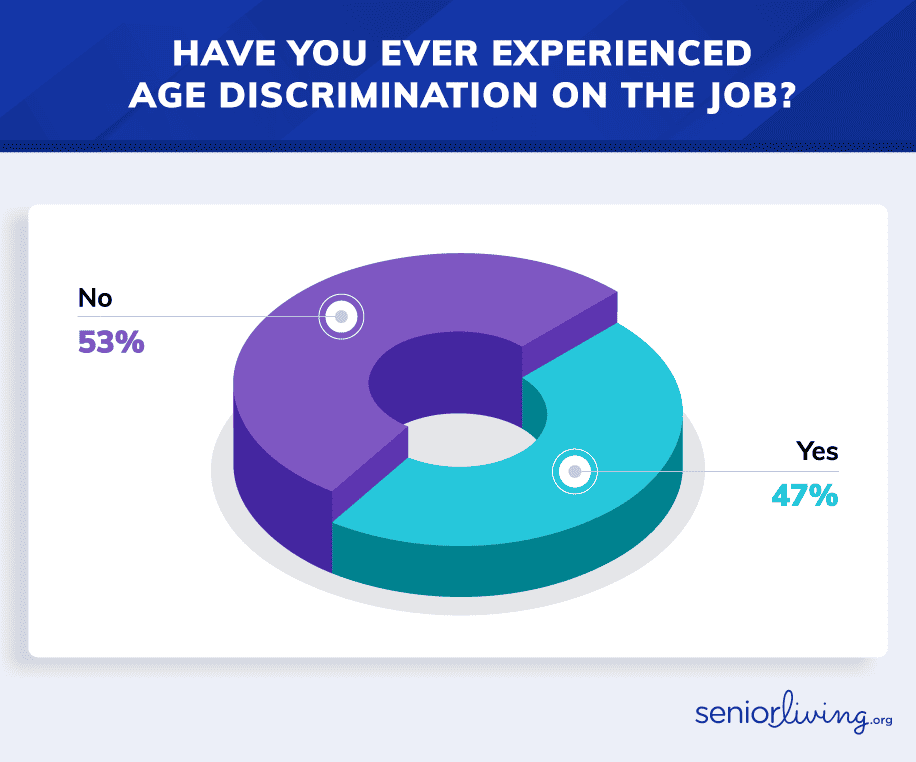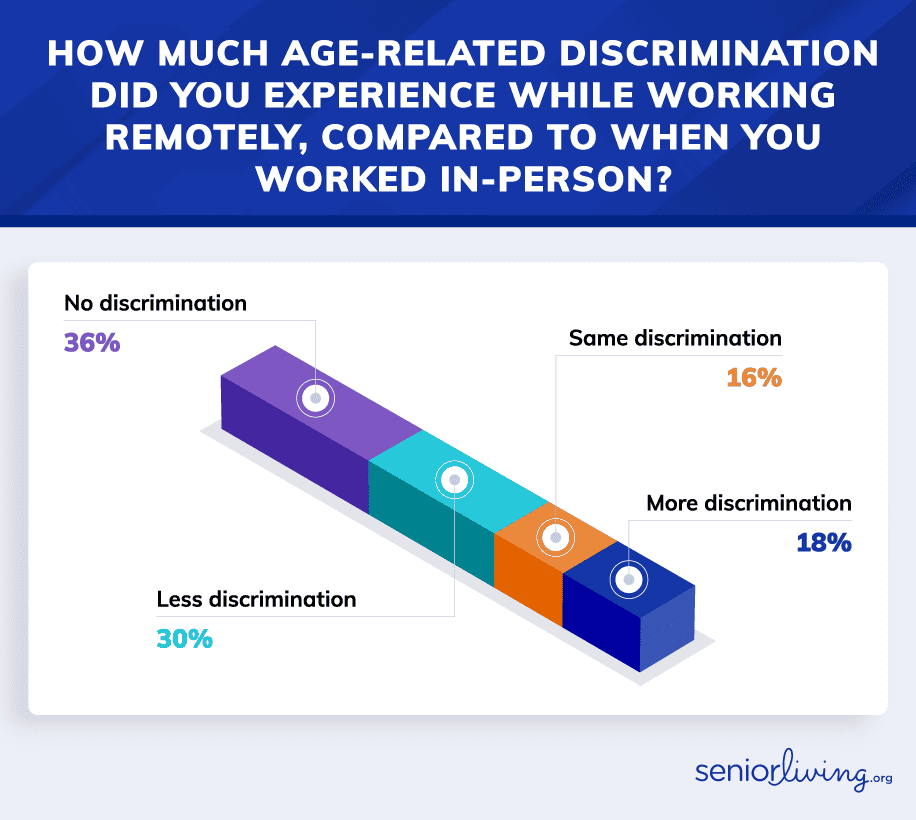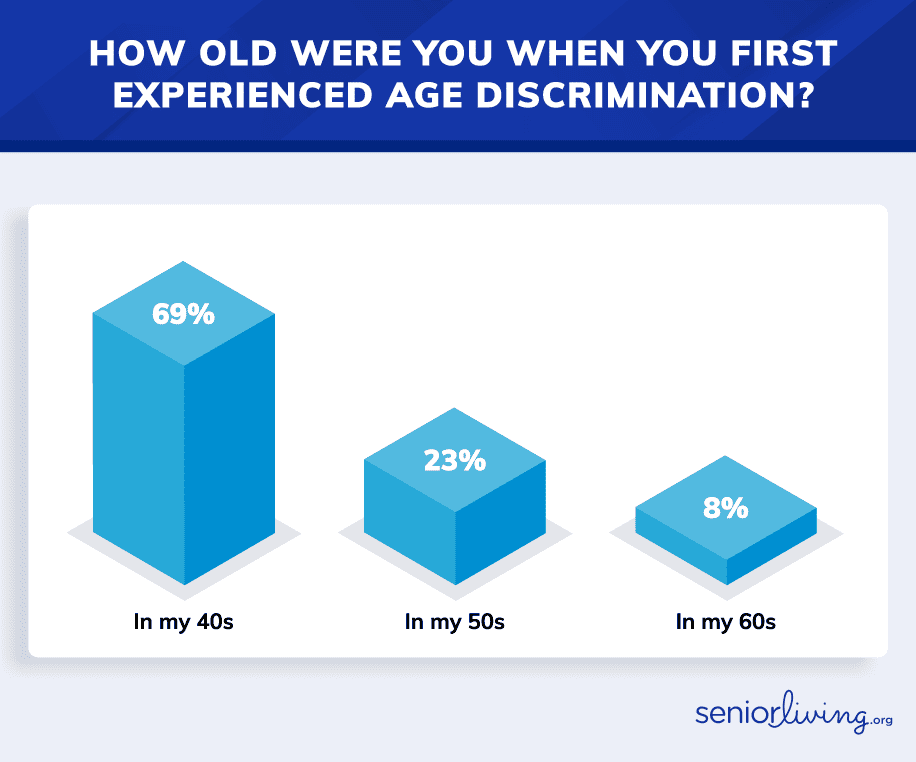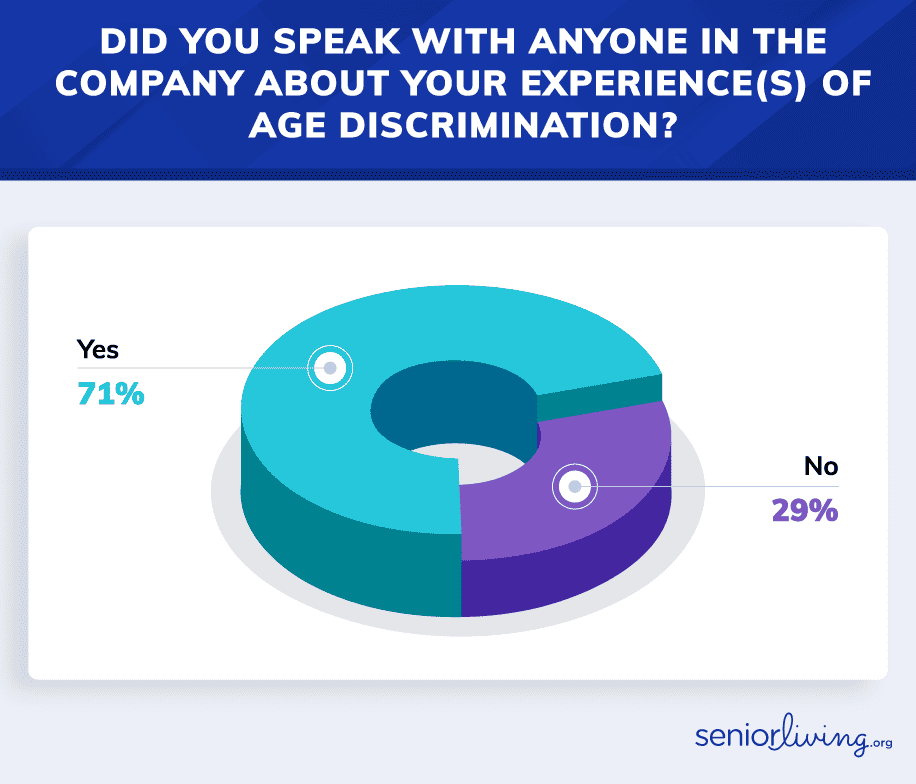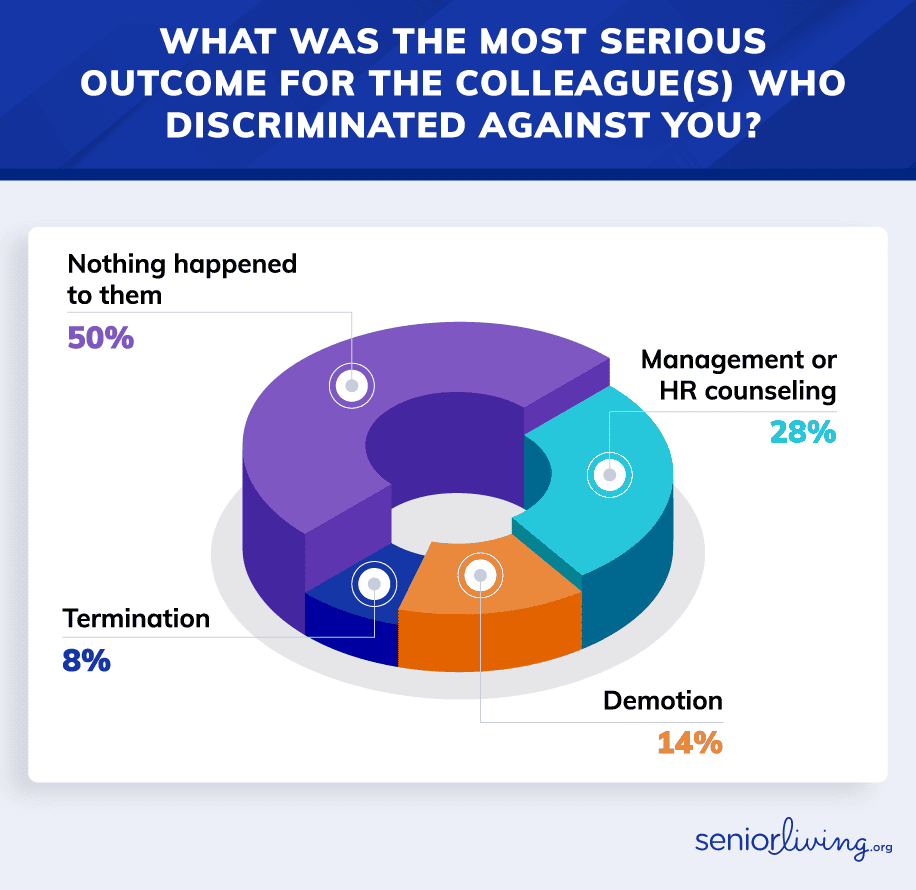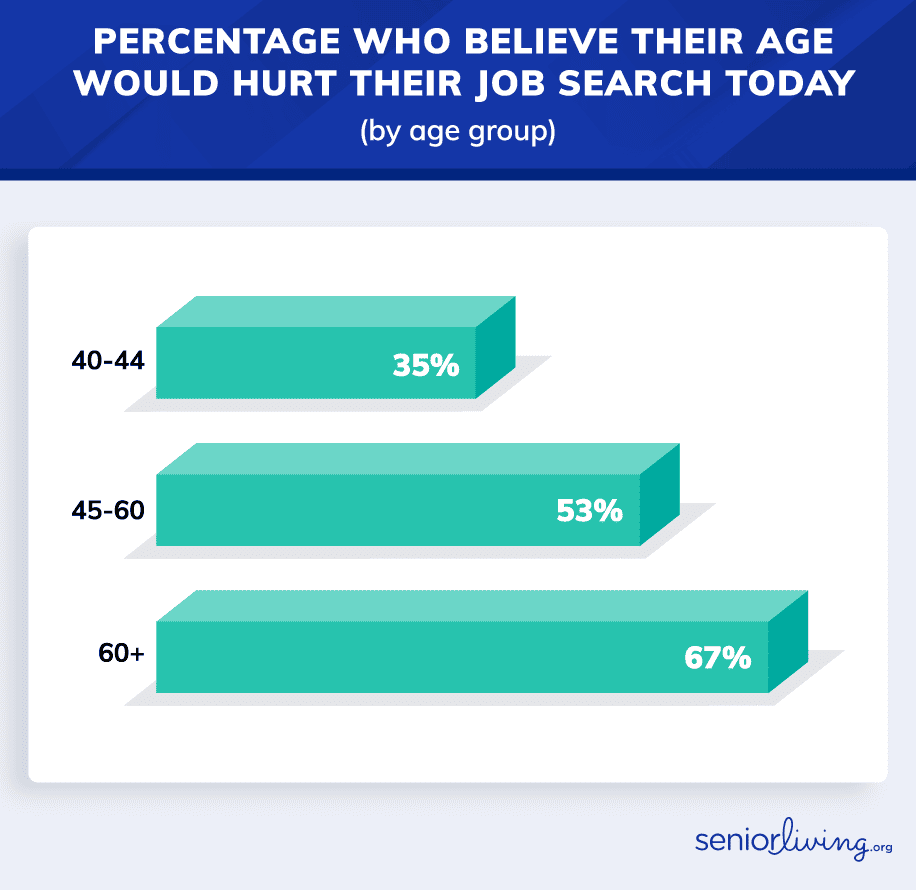Age Discrimination in the Workplace: 2023 Update
In an age of identity politics, it’s hard to believe that ageism still runs rampant. Though more companies are joining the fight against many forms of discrimination, such as race, gender, and sexual orientation, ageism remains an issue in workplaces nationwide.
Changing working conditions, climbing prices, and debate about raising the retirement age are luring older Americans back to work, forcing a reckoning with this deep-rooted bias that impacts nearly half of all employees over age 40.
To understand how age discrimination affects the nation, and to see how it’s changed since our last report, we asked more than 1,200 Americans aged 30 and older about their experiences with ageism in the workplace. Age discrimination is widespread, underreported, and begins earlier than most might expect.
Key Findings
- 47% of American workers over age 40 have experienced age discrimination or ageism in their careers. It happens at companies of all sizes and to both male and female professionals.
- The typical age when age discrimination first begins is about 45 years old.
- Though federal statistics show age discrimination has decreased over the last decade, we found that nearly a third of discrimination reports go unreported. This is often because victims worry that nothing will be done.
- 52% of older workers said that if they were to actively look for new jobs today, their age would negatively impact their job searches.
Table of Contents
- The Most Common Forms of Age Discrimination and Ageism
- Who is Most Likely to Face Age Discrimination?
- When Does Age Discrimination Start?
- Age Discrimination Reporting Statistics
- Tips for Confronting Age Discrimination
- Our Data
The Most Common Forms of Age Discrimination and Ageism
Age-based employment discrimination was outlawed by the Age Discrimination in Employment Act of 1967, which applies to private companies with 20 or more employees and all government agencies.
Specifically, the law protects workers over age 40 against discrimination in any aspect of employment, including hiring, firing, pay, job assignments, promotions, layoff, training, and benefits.
The Equal Employment Opportunity Commission (EEOC) investigates and enforces the law while recording all reported violations. Since 1997, the EEOC has received nearly one-half million age discrimination claims, with 12,965 complaints registered in 2021 alone (the latest reported year).
That number makes up about one-fifth of all employment discrimination claims. However, there has been a downward trend in age discrimination claims in recent years. Federal age discrimination claims fell nearly 9 percent from 2020 to 2021, and are down 45 percent over the past decade.
These numbers only tell part of the story, though. Our study revealed that less than half (49 percent) of those who experienced on-the-job age discrimination reported the occurrence to a manager or to human resources. Additionally, many workers may be unaware of their rights and suffer discrimination without seeking protection. As the ADEA also prohibits harassment based on age, derogatory remarks that create offensive work environments or drive adverse employment decisions are also considered unlawful discrimination.
In 2022, our study found only 9 percent of surveyed Americans believed they’d been the victim of age discrimination. This year we asked workers whether they'd experienced specific discriminatory behavior and discovered that nearly half of all employees over age 30 had encountered ageism on the job.
Specifically, we learned that beyond blatant offenses (such as unjust terminations, missed promotions, or reduced working hours), many had suffered insidious prejudices — including negative assumptions or veiled remarks.
| Which forms of age discrimination have you experienced in the workplace? | |
|---|---|
| Assumptions about ability to learn new skills | 19% |
| Missed raises or promotions | 16% |
| Less-desirable assignments/projects | 15% |
| Hiring or recruitment bias | 13% |
| Reduced hours | 13% |
| Harassment, ageist remarks, or jokes | 12% |
| Terminated or laid-off | 10% |
| Remarks suggesting retirement | 8% |
| Other | 2% |
Note: multiple selections allowed
Prejudiced phrasing and verbal harassment may be subtle forms of discrimination but still represent illegal age-based prejudices that disadvantage older workers.
Examples of ageism and discrimination include:
- Job postings seeking “recent graduates” or candidates who are “energetic” or “hustling” demonstrate a bias for younger applicants.
- Coded language in the workplace suggesting older employees are out-of-touch, can’t handle technology, don’t understand social media, or are no longer fit for stressful tasks are offensive and erode professional standing.
- Name-calling suggesting that experienced workers are “deadwood,” “over the hill,” an “old dog,” or “ready for retirement” all constitute harassment that contributes to an offensive work environment.
Additionally, some businesses discriminate by pressuring older workers to resign or retire. Employment attorney Chiquita Hall said, “Instead of terminating workers over age 55 for job performance, employers are pushing them out with an overwhelming amount of new changes. This has resulted in more forced resignations, buyouts, and terminations disguised as layoffs.”
Who is Most Likely to Face Age Discrimination?
Age discrimination occurs at companies of all sizes across all fields in every part of the country, affecting some workers at relatively early ages. Our study found that age discrimination is pervasive across professional, geographic, and demographic lines. Ageism reaches employees in all industries and locations, but some could be more problematic. Even remote workers experience age discrimination, as do those in the prime of their careers.
Industries with most age discrimination
According to EEOC statistics, the highest rates of age discrimination charges occur in the following fields: healthcare/social assistance, retail, manufacturing, and accommodations/food services.
Employees in those industries should be vigilant in these states with the highest rates of age-based charges:
| State | Age discrimination complaints per 100K residents |
|---|---|
| Nevada | 9.4 |
| Maine | 7.5 |
| Pennsylvania | 7.1 |
| Tennessee | 7.0 |
| Mississippi | 6.8 |
| Illinois | 6.6 |
Source: EEOC Charge Reports, 2021
Age discrimination occurs in large and small companies
Additionally, workers in companies of all sizes must be aware of potential ageism. Federal ADEA provisions apply to all private companies with 20 or more employees (and government agencies of any size). Yet, our survey found age discrimination takes place at businesses big and small.
| What was the size of the employer where you most recently experienced age-related discrimination? | |
|---|---|
| 1-9 employees | 12% |
| 10-99 employees | 29% |
| 100-499 employees | 22% |
| 500-999 employees | 15% |
| 1000+ employees | 22% |
Thirty-seven percent of respondents experienced age discrimination at companies with 500+ employees – large businesses with HR departments capable of education and vigilance.
Detractors say compliance is not a primary corporate priority because fiscal penalties are limited in ADEA actions. Victims of discrimination based on race, gender, religion, or disability may seek compensatory and punitive damages, but plaintiffs claiming age discrimination are entitled to little beyond back pay.
Age discrimination and remote work
As more and more people work from home, it may become more challenging to prevent age discrimination. Working from home can reduce opportunities for harassment, but it does not eliminate them. The increased use of technology, combined with an environment that lacks direct oversight or communal conformity, can create an atmosphere where insensitive tendencies are more likely to flourish.
For example, a team member working from home may be more likely to receive discriminatory emails or messages from their colleagues. They may also be more likely to be excluded from important meetings or projects. Additionally, the lack of direct supervision can make it more difficult to identify and address age discrimination.
Robert C. Bird, a professor of business law at the University of Connecticut’s Business School, also believes that perceptions associated with remote work may play against older employees. “Employers may associate remote workers with digital nomads, independent contractors or freelancers that work entirely remotely for multiple companies and do not have a single employer,” he said. “Working as a digital nomad is widely perceived as a younger person’s profession, and that can readily translate into discriminatory attitudes against older workers in remote spaces.”
Conversely, some experts believe that tech experience gained via remote work helps older employees prove their value. “With the increasing prevalence of remote work and digital communication, many older workers have had the opportunity to demonstrate their proficiency with technology and to adapt to new tools and platforms. This has helped to dispel some of the past stereotypes that have contributed to age discrimination, ” said Jonathan H. Westover of Human Capital Innovations.
When we asked remote workers to compare the age discrimination experienced from home to the ageism encountered in person, one-third reported no discrimination. Still, one-third said discrimination was the same or worse while remote.
When Does Age Discrimination Start?
We may imagine ageism victims as gray-haired veterans in the twilight of a career, yet many Americans faced discrimination much earlier in life. Nearly one-third of all workers encountered age discrimination before age 50. Among those who’ve experienced ageism in the workplace, more than two-thirds say it began in their 40s.
The median age at which respondents first experienced age discrimination was 45, hardly older than the median age of the American workforce, which is currently 42 years. The age of the first discrimination was the same for male and female professionals.
Discrimination affects a wide range of ages regardless of industry, business size, geography, or remote working situation. How much of the behavior is reported, and how do companies respond?
Age Discrimination Reporting Statistics
Age discrimination is a problem that won't go away unless people speak up about it. We found that many people who experience age discrimination at work don't report it. There are many reasons for this, including fear of retaliation, a lack of confidence in the reporting process, and a belief that nothing will be done.
| Who in the company did you speak with about the discrimination you experienced? | |
|---|---|
| Manager or team leader | 33% |
| Co-workers at my level | 31% |
| Human Resources | 23% |
| Company executives | 13% |
| Business owner | 6% |
| Other | 2% |
Note: multiple selections allowed
About 70 percent of people who experienced discrimination told at least one person about it. Still, many others did not. The primary reason for failing to report age discrimination is the belief that companies will fail to address the issue. These fears are well founded. When employees did complain about ageist behavior, no action was taken in half of the cases.
| Why did you choose not to speak with anyone about the discrimination? | |
|---|---|
| Knew nothing would be done | 62% |
| Didn’t want to draw attention | 34% |
| Feared backlash from reported offender | 25% |
| Feared negative treatment by colleagues | 23% |
| Didn’t want to explain the discrimination | 21% |
Note: multiple selections allowed
Experts suggest responding to reports of discrimination quickly and directly to create the best opportunities for rectification and improvement. Studies also indicate that initial positive responses to offensive behavior are more productive than accusatory ones.
Many people who experienced discrimination at work were afraid to report it. They were worried about negative attention or backlash from their colleagues or supervisors. This fear is powerful among workers over 45, who believe their age would make it difficult to find a new job if fired for reporting discrimination.
In a job market where companies have trouble retaining workers, it's employers who should fear rampant ageism. Enforcing ADEA standards is the right approach ethically, morally, and legally – but it also makes good business sense.
We found that employees were more likely to stay with companies where they felt safe enough to report age discrimination. Also, they were twice as likely to remain on board when their complaints led to corrective action.
Tips for Confronting Age Discrimination
Preventing age discrimination requires a holistic approach where everyone does their part: Employers must have clear policies and enforce them consistently. Employees of all ages need to be aware of the issue and be willing to speak up if they see something wrong.
It is essential to be vigilant when age divides are becoming more entrenched. This can happen when there is a lot of change in the workplace, such as when a new generation of workers is entering the workforce.
Discrimination attorney Kelly Michael Hundley warns that ageism will likely worsen with shifting demographics. “Older workers still face the same stereotyped assumptions about what they can and can’t do coupled with the assumption that they’re just riding out things to retirement. In my opinion, this is likely to be enhanced by an aging workforce countered by management that continually grows younger,” said Hundley.
The following advice can help employers to reverse this trend and achieve more equitable workplaces and hiring practices:
In the hiring process:
- Avoid language that suggests a preference for younger applicants (such as “hustle”, “new grads”, or “energetic”).
- Advertise in a variety of places to reach a diverse audience.
- Don't request age-related information, such as date of birth or graduation year, unless it is absolutely necessary.
In workplace policies:
- Have clear policies that prohibit age discrimination.
- Make sure everyone in the company knows about these policies.
- Enforce the policies consistently.
- Discipline employees who violate the policies.
In onboarding and training processes:
- Make sure new hires understand the company's policies on age discrimination.
- Provide ongoing training on diversity and inclusion.
- Plan activities that promote teamwork, trust, and respect for all employees.
When offering promotions and raises:
- Make all employment decisions based on merit, not age.
- Don't make decisions based on assumptions about an employee's age.
- Don't make decisions that could be perceived as discriminatory.
When reporting discrimination becomes necessary, it's important to thoroughly document offenses and start the process with the human resources department. If a company's response is insufficient, victims of ageism at companies with 20+ employees have the right to file a complaint with the federal EEOC. It's illegal for colleagues or employers to retaliate for any such filing. Therefore, complainants should carefully take note of any punitive behavior.
Conclusion
More people are working later into their lives because of low unemployment, rising prices, and longer lifespans. Even though the workforce is becoming more diverse and inclusive overall, ageism remains a problem for businesses of all sizes.
The problem continues, in part, because less than half of workers reported discrimination to proper authorities and half of the reported cases ended without disciplinary action.
Unchecked ageism seriously harms older Americans and leads to job churn rates that negatively impact bottom lines. With more assertive employment policies, greater awareness, and stronger laws, we can create a more inclusive and welcoming workplace for everyone, regardless of age.
Our Data
In April 2023, we conducted an online poll of 1,203 current or retired workers aged 40 or older. 54 percent were female and 46 percent were male. 27 percent were between ages 40-44, 45 percent were aged 45-60, and 27 percent were older than 60. About 47 percent reported facing some form of age discrimination in the workplace at some point during their careers. We previously conducted research on this topic in 2021, but due to a change in methodology, past results are not comparable to our latest data.
We also explored age discrimination charge statistics from the Equal Employment Opportunity Commission from 2021, the most recent year available. The data are compiled by the Office of Enterprise Data and Analytics from data reported from EEOC's Charge Data System and EEOC's Integrated Mission System.
Are you a journalist or researcher looking for data or expertise to support your work? See our open data portal, or reach out to us at open-data@seniorliving.org to connect with an expert on aging in America.

